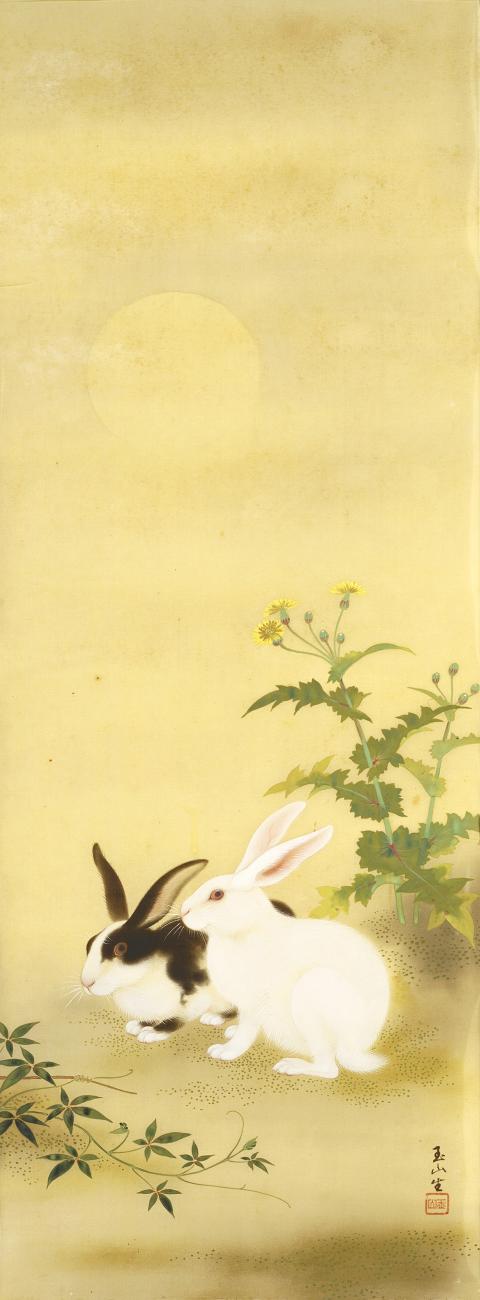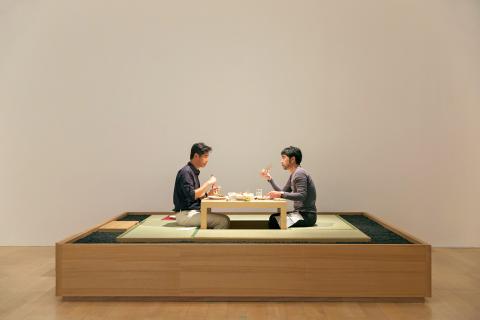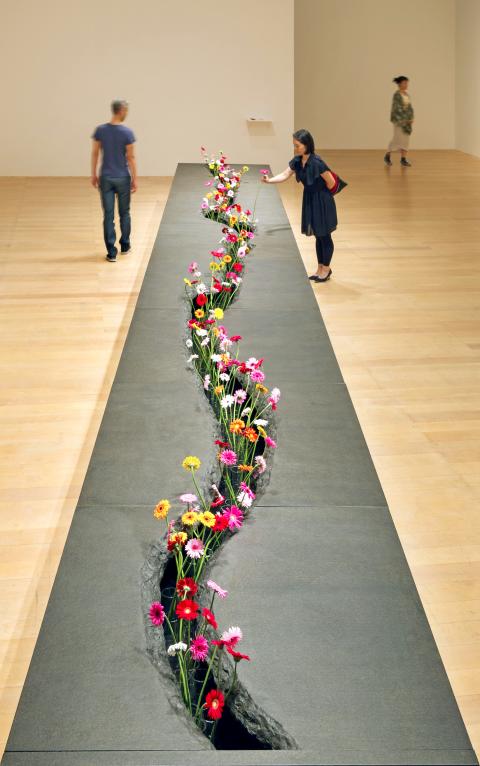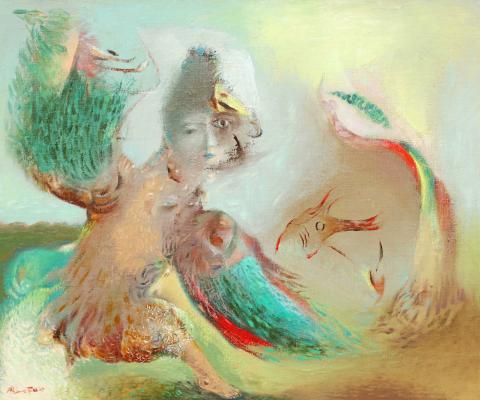Not only does Alixe Fu (傅慶豊) have a cool name, but he has some pretty cool art as well. In his current exhibition, Sign Me (臉譜), held at ArtDoor Gallery, visitors are invited to sign their names and write messages on a giant-sized statue. The purpose is to facilitate conversation between artist and viewer. In addition, Fu’s floor-to-ceiling oil paintings of grotesque, distorted human faces with tiny fish swimming in them will also be on display. His style can be seen as satire on the traditional practice of painting portraits. A person’s face holds a wealth of information that can be hidden behind a pleasant smile. Fu simply unleashes the demons behind that smile.
■ ArtDoor Gallery (藝境畫廊) 639, Ruiguang Rd, Taipei City (台北市瑞光路639號), tel: (02) 2658-5268. Open Tuesdays to Sundays from 11am to 7pm
■ Opens tomorrow. Until June 28

Photo courtesy of Taipei Fine Arts Museum
South Korean fashion and pop music is so popular these days, that it’s easy to overlook the country’s rich artistic tradition. Melting Domain: Triangular Matrix of Korean Arts (融域:韓藝三個路) is an exhibition at Taipei’s Yi&C Contemporary Art, a sleek furniture store that doubles as an art gallery, featuring the works of three South Korean artists from different generations: Kim Sun, Switzerland-based Yang Kwang-ja and US-based Kim Bong-tae. Curated by Moon Jung-hee, a visiting professor at Tainan National University of the Arts, the exhibition centers around mixed media — particularly the intersection of multimedia and collage — as an increasingly popular art form. The influence of Western and Eastern techniques, as well as questions of identity are evident in the works of all three artists, creating a unifying thread characterizing Korean contemporary art over the decades.
■ Yi&C Contemporary Art (易雅居當代空間館), 22, Ln 252, Dunhua S Rd Sec 1, Taipei City (台北市敦化南路一段252巷22號), tel: (02) 2781-3131. Open Mondays to Fridays from 10am to 7pm and Saturdays and Sundays from 2pm to 6pm
■ Until June 28

Photo courtesy of Taipei Fine Arts Museum
Born in San Francisco at the turn of the twentieth century, photographer Ansel Adams was most well-known for his iconic black-and-white landscape images of the American West, particularly Yosemite National Park. Adams helped develop a technique to ensure greater clarity and depth in photographs and he used large format cameras for higher resolution. His dramatic prints capturing the roaring mountains and valleys aided in pushing the medium of photography into the realm of fine arts. Twenty-nine of his 8 by 10 prints are currently on display at Taipei’s 1839 Contemporary Gallery in an exhibition entitled Ansel Adams: Yosemite Special Edition (安瑟亞當斯:優勝美地特展).
■ 1839 Contemporary Gallery (當代藝廊), B1, 120 Yanji St, Taipei City (台北市延吉街120號B1), tel: (02) 2778-8458. Open Tuesdays to Sundays from 11am to 8pm
■ Until June 28

Photo courtesy of Taipei Fine Arts Museum
Fashionistas will be happy to know that the National Museum of History currently has an exhibition on women’s fashion. Entitled Spectacular Fabrics from a Fashionable Time: Ladies’ Textiles of the Qing Dynasty (潮代清繡的天衣無縫:清代女性服飾展 ), the exhibition showcases an elegant selection of garments and jewelry worn by empresses and concubines of the Qing imperial court. As with previous dynastic rules, when the Manchus ousted the Ming rulers in 1644, they established their own dress code. The results were regal Manchu-style robes with Han patterns and embroideries. The qipaos of early Republican China are what usually comes to mind when thinking of feminine beauty, but the exhibition shows that Manchu robes, though more conservative, were tasteful and elegant as well.
■ National Museum of History (國立歷史博物館), 49 Nanhai Rd, Taipei City (台北市南海路49號), tel: (02) 2361-0270. Open Tuesdays to Sundays from 10am to 6pm
■ Until Aug. 9

Photo courtesy of Taipei Fine Arts Museum
The Taipei Fine Arts Museum starts out the summer months strong with a solid lineup of exhibitions. The solo exhibition by Taichung-born, New York-based artist Lee Ming-wei (李明維) is not to be missed. Curated by Tokyo’s Mori Art Museum Lee Ming-wei and His Relations: The Art of Participation (李明維與他的關係:參與的藝術) features 15 of Lee’s participatory art projects over the last 20 years. If you’re the type of viewer who is always irked by the fact that you’re not supposed to touch the art, then you’ll be happy to know that Lee’s work was created for maximum interaction. Taking up entire rooms, viewers are meant to pick flowers, flip through books and sit at dining room chairs pretending to eat dinner. The projects are also highly personal. The Letter Writing Project was conceived after Lee’s grandmother passed away and he felt compelled to share his thoughts with her. The Dining Project started when Lee was in graduate school at Yale University. Feeling lonely, he invited strangers over to share food and ideas. The participatory nature of the artwork enables viewers to feel what Lee felt, offering a glimpse into the artist’s heart and mind. This is something which is so often obscured in other artistic mediums. Formosa in Formation: Selected works from the Taipei Fine Arts Museum Collection (臺灣製造‧製造臺灣:臺北市立美術館典藏展), on the other hand, may be an exhibition where you’re not allowed to touch the paintings, but it’s still just as fascinating as Lee’s participatory art. The Japanese colonial era from 1895 to 1945 has left an indelible mark in the Taiwanese psyche in terms of language, customs and pop culture. The exhibition, which includes works from both Taiwanese and Japanese artists, explores the roots of this legacy. With the bulk of the artwork dating back to the 1930s — when the Land of the Rising Sun was at its zenith — some of the works seem to glorify the heyday while others have a more distinctive Taiwanese flair. Artists at this time struggled to reconcile notions of identity, as well as severing tradition and embracing new constructs.
■ Taipei Fine Arts Museum (台北市立美術館 TFAM), 181, Zhongshan N Rd Sec 3, Taipei (台北市中山北路三段181號), tel: (02) 2595-7656. Open Tuesdays to Sundays from 9:30am to 5:30pm and until 8:30pm on Saturdays
■ Lee Mingwei runs until Sept. 6. Formosa in Formation runs until Sept. 29

Photos courtesy of Art Door Gallery

Wooden houses wedged between concrete, crumbling brick facades with roofs gaping to the sky, and tiled art deco buildings down narrow alleyways: Taichung Central District’s (中區) aging architecture reveals both the allure and reality of the old downtown. From Indigenous settlement to capital under Qing Dynasty rule through to Japanese colonization, Taichung’s Central District holds a long and layered history. The bygone beauty of its streets once earned it the nickname “Little Kyoto.” Since the late eighties, however, the shifting of economic and government centers westward signaled a gradual decline in the area’s evolving fortunes. With the regeneration of the once

Even by the standards of Ukraine’s International Legion, which comprises volunteers from over 55 countries, Han has an unusual backstory. Born in Taichung, he grew up in Costa Rica — then one of Taiwan’s diplomatic allies — where a relative worked for the embassy. After attending an American international high school in San Jose, Costa Rica’s capital, Han — who prefers to use only his given name for OPSEC (operations security) reasons — moved to the US in his teens. He attended Penn State University before returning to Taiwan to work in the semiconductor industry in Kaohsiung, where he

On May 2, Chinese Nationalist Party (KMT) Chairman Eric Chu (朱立倫), at a meeting in support of Taipei city councilors at party headquarters, compared President William Lai (賴清德) to Hitler. Chu claimed that unlike any other democracy worldwide in history, no other leader was rooting out opposing parties like Lai and the Democratic Progressive Party (DPP). That his statements are wildly inaccurate was not the point. It was a rallying cry, not a history lesson. This was intentional to provoke the international diplomatic community into a response, which was promptly provided. Both the German and Israeli offices issued statements on Facebook

Perched on Thailand’s border with Myanmar, Arunothai is a dusty crossroads town, a nowheresville that could be the setting of some Southeast Asian spaghetti Western. Its main street is the final, dead-end section of the two-lane highway from Chiang Mai, Thailand’s second largest city 120kms south, and the heart of the kingdom’s mountainous north. At the town boundary, a Chinese-style arch capped with dragons also bears Thai script declaring fealty to Bangkok’s royal family: “Long live the King!” Further on, Chinese lanterns line the main street, and on the hillsides, courtyard homes sit among warrens of narrow, winding alleyways and